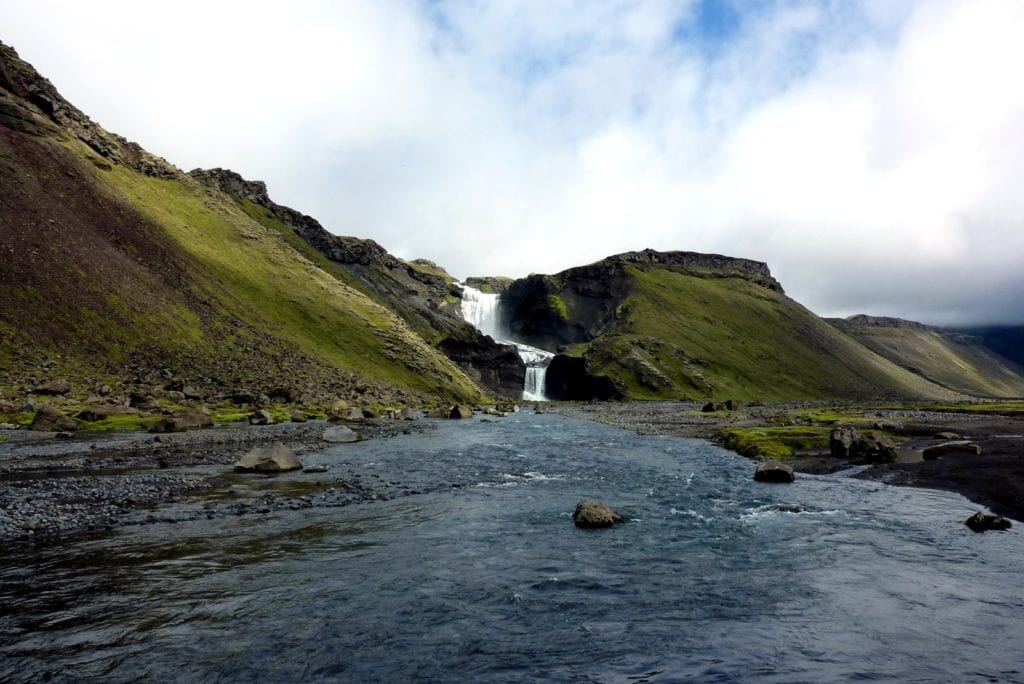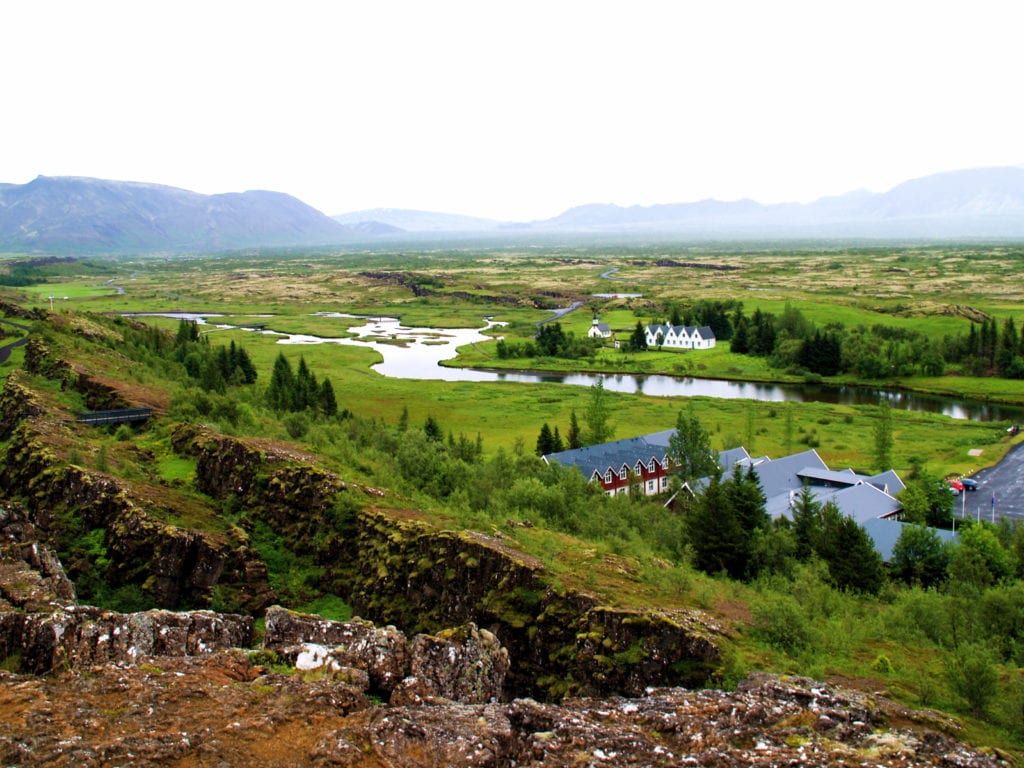Towering waterfalls, tranquil fjords, dramatic cliffs, green fields — many visitors to Iceland are drawn to its natural beauty. Though Iceland’s wild outdoor beauty is on display everywhere — from the Golden Circle, to the Westfjords, and beyond — nowhere is it more dramatically on display than in Iceland’s three National Parks.
As with the world, National Parks in Iceland were formed in order to preserve pristine areas and protect wildlife. By providing a place where people can respectfully hike, climb, and explore, Snæfellsjökull, Vatnajökull, and Þingvellir National Parks are a must-see for any Iceland visitor who wants to see nature at its most pure. With our ultimate guide to Iceland’s National Parks, we’ll take a deeper look at their history, attractions, and unique story — and how you can easily drive to, explore, and sight-see in the parks.
Vatnajökull National Park

At one point, Iceland contained a total of five national parks. In 2008, two of these parks — Jökulsárgljúfur (established 1973) and Skaftafell (established 1967) — were incorporated into Vatnajökull. Although there are now only three national parks in the nation, those who visit Vatnajökull still have the chance to visit the areas formerly occupied by separate parks.
This area gets its name from the Vatnajökull glacier which it encircles. As a park centered around Europe’s largest glacier, Vatnajökull National Park is enormous and covers 14% of Iceland’s total area. Recently, the park was made into a UNESCO World Heritage Site. With ten volcanoes (eight of which exist beneath the glacier), the area protects a unique ecosystem.
Getting to Vatnajökull National Park
To get started on your journey into this massive national park, it’s best to go to the Skaftafell Visitor Center. Here, you’ll learn about the various trails, activities, and attractions in the area. If you’re driving to the Skaftafell Visitor Center from Reykjavik, take Road 1 to the east for 326 km, then Road 998 for 2 km to arrive at the visitor center and start your journey.
Areas to Explore in Vatnajökull National Park
- Skaftafell. Initially established as a national park in 1967, the Skaftafell area is now just one part of Vatnajökull. Nevertheless, it still offers an incredible range of sights for travelers, including waterfalls, mountains, and numerous hiking trails. For example, intrepid climbers might consider the challenge of the highest peak in Iceland, Hvannadalshnjúkur.
- Svartifoss Waterfall. In the Skaftafell area, you can find the Svartifoss waterfall. The word “svartifoss” means black falls, which describes the striking columns of lava-formed basalt that surrounds the waterfall. In fact, the unique beauty of this waterfall has inspired the design of several architectural pieces in Iceland.
- Vatnajökull Glacier. No trip to this national park would be complete without a glimpse of this world-famous glacial region, which astounds visitors with its volcanic ash, stunning ice caves, and glacial lagoons. Because it encompasses a massive area, it’s often wise for visitors to choose a destination ahead of time. For example, if you visit the park in the wintertime then you might want to explore the vast crystal ice caves that stretch beneath the glacier; to do so, it’s important to secure a guide ahead of time.
- Jökulsárgljúfur. Formerly a national park in its own right, the Jökulsárgljúfur area is still accessible to visitors and makes for an incredible experience. Located at the north of the park, this area is known for the incredible winding canyon carved by water flowing from the Vatnajökull Glacier. Visitors will also want to check out the area’s four breathtaking waterfalls: Selfoss, Dettifoss, Hafragilsfoss and Réttarfoss. There are several hiking trails in the area that can help you explore all the features that define Jökulsárgljúfur.
Snæfellsjökull National Park
Snæfellsjökull National Park boasts some of the most striking and diverse natural beauty in all of Iceland. Lava caves, basalt fortresses, waterfalls, expansive beaches — all of these incredible sights exist within the borders of this park. Founded in 2001, this park surrounds its namesake, the spellbinding Snæfellsjökull glacier.
In addition to its striking scenery, this park is popular with those who love catching a glimpse of diverse wildlife. The coastline is also of cultural and historical significance due to the many fishermen who have taken advantage of the rich waters. When visiting Snæfellsjökull National Park, give yourself enough time to soak in the incredibly unique geography of this area.
Driving to Snæfellsjökull
To reach this national park from Reykjavik, you have to travel to the tip of the Snæfellsnes Peninsula in Western Iceland. The drive will take around 2 hours and 40 minutes, but is fairly straightforward: just take Road 1 north from Reykjavik to Bogarnes, then take Road 54 the rest of the way. Further, along the way to the National Park, you will probably want to stop and enjoy some of the other incredible sights of the Snæfellsnes Peninsula.
What to See at Snæfellsjökull National Park
- Snæfellsjökull glacier. If you’re looking for a true adventure, schedule an expedition up Snæfellsjökull glacier. It is the setting of Jules Vernes’ famous book Journey to the Center of the Earth. If a glacier hike isn’t in the cards, simply glimpsing Snæfellsjökull is worth a trip.
- Beaches: Djúpalónssandur and Skarðsvík. Uniquely situated on the coast, Snæfellsjökull is a great place to experience some of Iceland’s incredible beaches. For example, Djúpalónssandur is a pebbled beach that shelters a shipwreck — and is said to harbor ghosts. Or check out Skarðsvík, which features a golden sandy beach framed by beautiful blue water and dramatic basalt rocks.
- Lóndrangar basalt fortress. To see a truly unforgettable sight, check out the romantic, haunted-looking Lóndrangar basalt cliffs that jut out from the sea along the coast.
- Vatnshellir lava cave. 8,000 years old and 35 meters down, this lava cave experience is a must-see for intrepid explorers (who don’t mind using a flashlight to see the scenery).
Þingvellir (Thingvellir) National Park

In addition to preserving an area of stunning natural beauty, Þingvellir National Park has significant cultural significance. This historic site served as the site of the parliament fields of Alþingi, which was of vital political significance to the Viking Age commonwealth. Established in 930, this assembly represented and unified all of Iceland. Also, this area was vital for speeches, gatherings, legal disputes, and political processes.
In 1844, the location of Alþingi was moved to Reykjavik. In 1928, the area was designated a National Park and in 1944, Icelanders celebrated their independence from Denmark at Þingvellir. Surrounded by mountains with green fields, Þingvellir’s location on top of the Mid-Atlantic rift makes it a destination.
Driving to Þingvellir
If you’re coming from Reykjavik, it is a manageable 45 km drive to get to Þingvellir. Simply take Road 1 heading north from Reykjavik, go through the town of Mosfellsbær, and take the exit to Road 36. This national park is one of the stops that’s easily accessible from Iceland’s Golden Circle, and so can easily fit into your itinerary if you’re planning on visiting the Golden Circle.
What to Do in Þingvellir National Park
- Hike to abandoned farms. If you love the idea of hiking and history at the same time, then you’ll want to check out the hiking trails that are easily accessible from Þingvellir, many of which traverse the abandoned farms of Hrauntún, Skógarkot, and Vatnskot. Delicate flowers, fierce lava cliffs, pristine waters, and verdant green landscapes make any hike in Þingvellir truly spectacular.
- Horseback ride on scenic trails. Þingvellir is an incredibly scenic place to horseback ride. There are two trails that are accessible for horses. On one hand, one will take you on the Skógarkotsgata trail into the Stekkjargjá fault, which is famous for being featured in the HBO show Game of Thrones. On the other hand, the other trail will take you to scenic mount Ármannsfell.
- Snorkel in Lake Þingvallavatn. This rift valley lake is especially unique because of its interaction with minerals from the surrounding lava, and its location on the mid-Atlantic rift. Full of algae, vegetation, and unique freshwater fish, it’s an incredible place to snorkel and explore.
- Dive in Silfra. One of the most fascinating and unique elements of this National Park is the Silfra fissure. It was created by the shifting tectonic plates that the park sits on. It’s the only place in the world where divers can sink in between the American and Eurasian continental plates. While diving in Sifra — which boasts the clearest water — you’re in the rare position of being between two continents.
Explore the National Parks in Iceland
Iceland is a unique nation that teems with natural, wild beauty. Exploring its three unique national parks in Iceland is one of the best ways to see this country. When traveling the sometimes-unpaved roads of Iceland, make sure that your vehicle can handle the terrain and help you make the most of your trip. Ready to get started on planning the national park adventure of a lifetime? Find your rental car in Iceland here.
Back